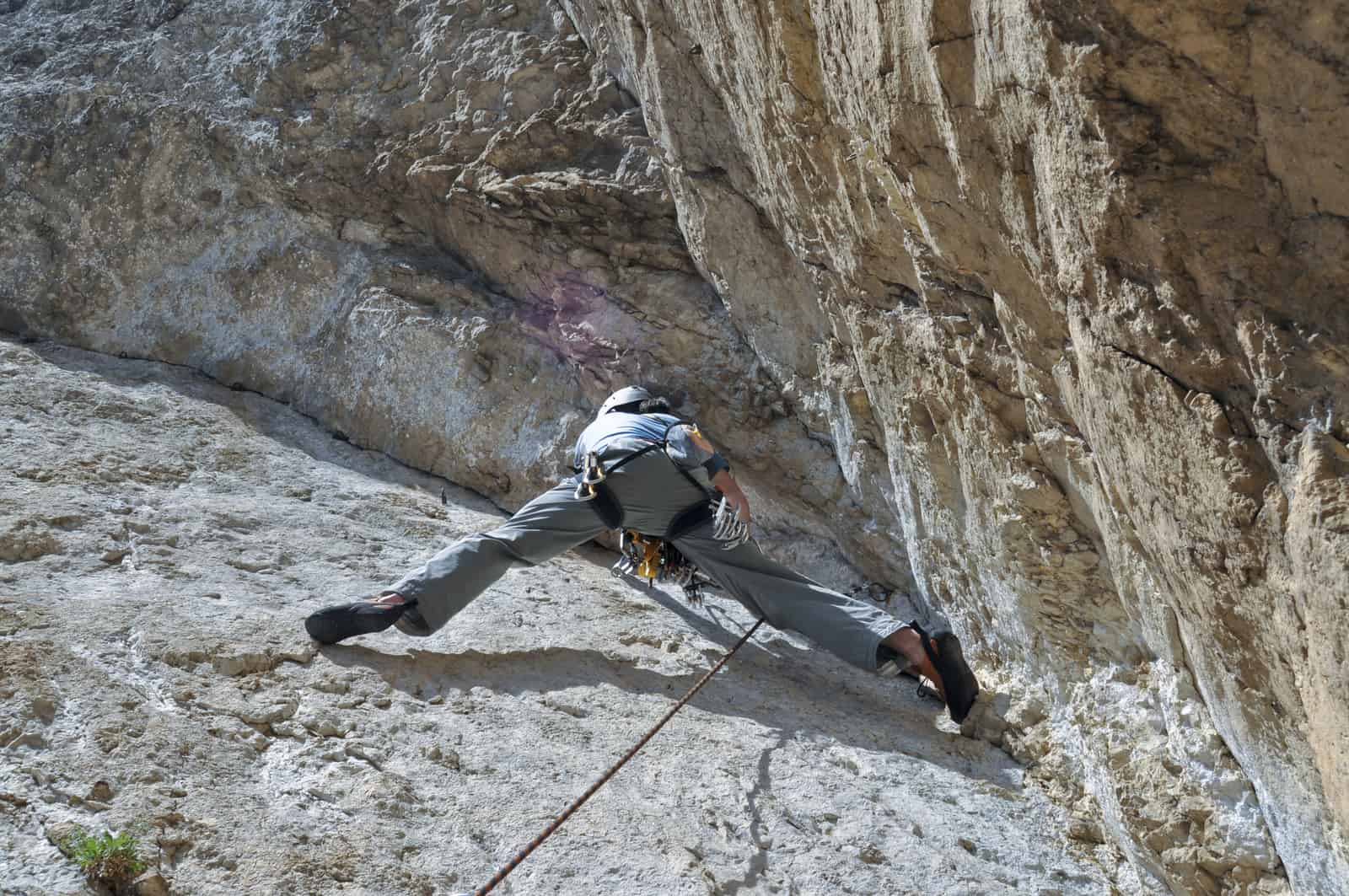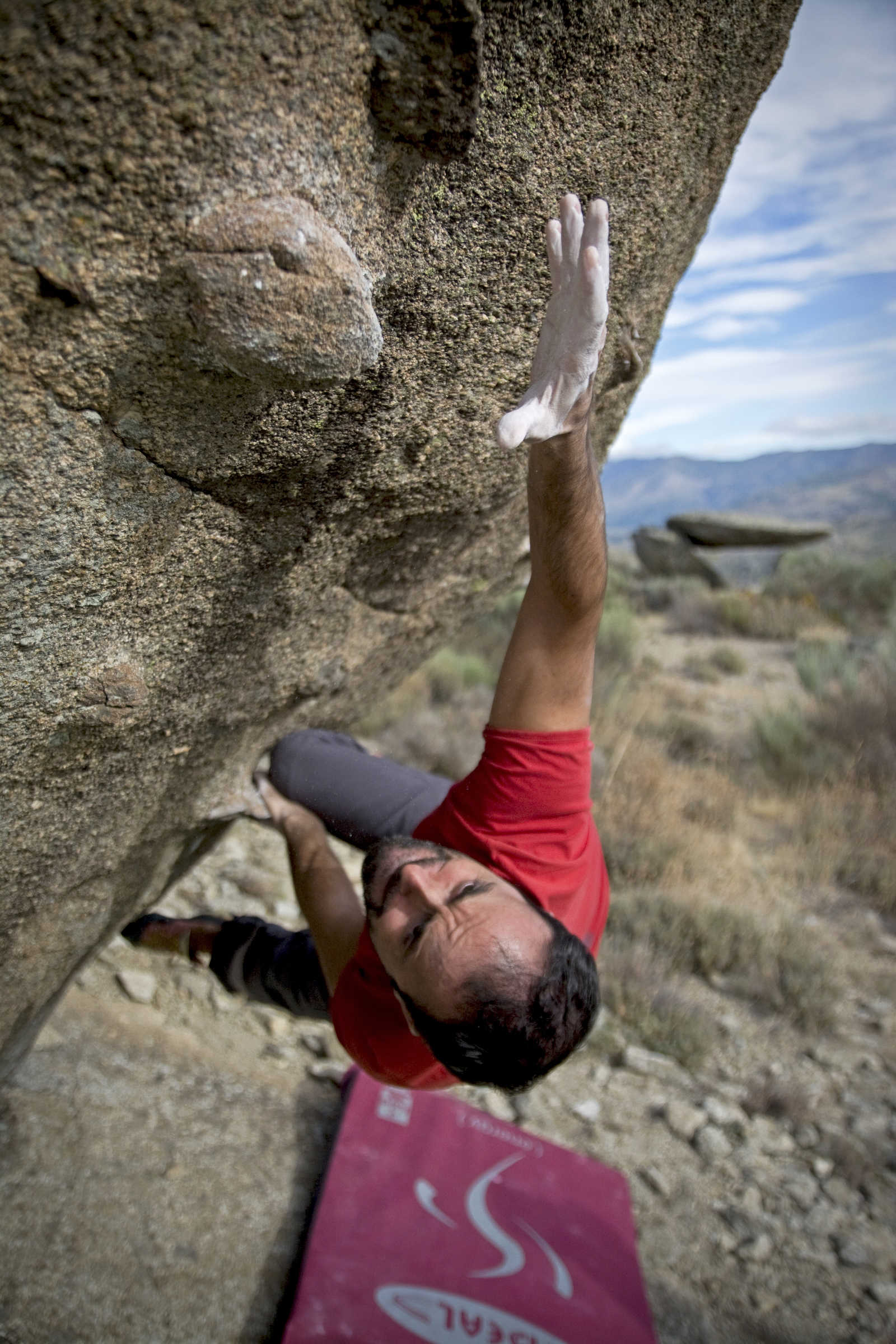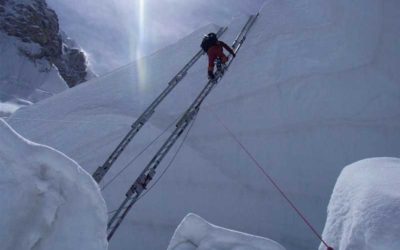
I have suffered fear from falling when climbing. I would repeatedly bail or fall from routes that I felt were well within my ability because of it. It quickly got to the point where it started interfering with my enjoyment of leading when climbing both mountains or indoors.
Here I will try to outline everything I have learned when trying to solve this nuisance.
I’m a cautious kind of person and am happy being limited by my lowish tolerance for risk (that’s a decision I take), but the fear is not rational – e.g. I have no fear while clipping the 2nd bolt although a fall here is probably the worst place on an indoor wall to fall.
I get to a point where I’m scared and just freeze – I know the next move but my arms and legs just will not obey so I hang there, get tired and panicked and then either down climb to the previous bolt or fall off.
What makes Fear of Falling in Lead Climbing Worse:
- Being above a bolt
- Body weight not above feet (side pull, overhangs)
- Empty space below me (overhangs, stepping across onto the other side of a dihedral)
- Dynamic moves
- I know many who have taken a few falls, but that don’t seem to get used to it. The irony is that I quite enjoy a big fall as soon as I have left the wall. Up to that point, it’s all panic and terror and climbing badly. So how do you overcome this?
How NOT to get rid of Fear from Falling
I’ve tried several techniques to help with this with mixed result. From my personal experience the below didn’t work for me (they may for you).
-
Fall training, i.e. taking a fall deliberately to get used to it.
This helps with your fall technique but for me it failed to address the issue. I wasn’t scared of taking a controlled fall. I was scared that I couldn’t hold on while clipping, etc.
-
People shouting encouragement/telling to get on with it
This just annoyed me/made me more frustrated than anything, which made me not want to get into that situation even less, which made me more annoyed at them and me, repeat until I end up shouting at them to simply p**s off and storming away from the crag in a terrible mood.. 🙂
-
Putting pressure on yourself to succeed
Partly as a result of the above, I ended up getting into a mindset that I was just being silly and I should just man up and get on with it. again, for me, this simply made the matter worse, to the point where the grade I could lead gradually got worse.
How to Get Rid of Fear of Falling
Ok, so what did work for me:
-
Coming to terms with it.
You will get scared, that’s fine; don’t fight it, just accept it. “Ok I’m scared, now what”. This helps you think though the panic.
-
Turn your brain on to fight your chemical response
Panic/fear is a chemical response for being in a dangerous situation. Your body is flooded with Adrenaline and you go into fight or flight mode. So do you fight or flight? Well neither: you’re 10 meters off the ground attached to a rope, neither option is helpful.
You have two options, fall (fine you’re not bothered by this but ultimately this just releases more adrenaline and makes matters worse) or engage your brain and out-think your chemical response.
Start concentrating on what’s around you, focus on your breathing, get this under control: you’re safe, remember that, where’s the next really good hold, I need 5 mins to just get myself in order, try not to down climb but if you do, do it slowly and controlled.
-
Stay put/stay calm
Try and wait it out. Don’t simply let go and don’t downclimb. Wait, close your eyes, concentrate on your breathing, wait for the adrenaline to die down to an acceptable level, then continue.
Try and hold on at this point (as opposed to letting your belayer “take”), realize you can probably hold at this point longer than you think. Rationalize the situation.
-
Don’t freeze
Ok, I know I said to stay put (above), but this can only get you so far, at some point you’re going to need to do something.
So do something. Plan what you’re going to do, work out what you’re going to hold onto, where you’re going to put your feet and then do it slowly and deliberately while breathing though the panic. Again, rationalize the situation.
-
Try to turn the negative into a positive
So you get scared when you climb and get swamped with adrenaline?! Isn’t this why you’re doing this? for the buzz? The Adrenaline! Turn the negative into a positive. Next time you get scared, try and enjoy it! I know this can be hard but adrenaline can be pretty enjoyable if you learn to deal with the fight or flight response.
-
Break the vicious cycle
You get frustrated because you’re not climbing at your ability which makes your more anxious which makes you push yourself, which makes matters worse, repeat. STOP, go for a boulder, relax, enjoy yourself, the wall’s not going anywhere and you can come back whenever you want. You’re supposed to be enjoying this!
-
Visualization
This is where you visualize the moves and convince yourself you can do it, etc. I’ve now started using this more and more. I often find that working though moves in my head, thinking about falling, etc. repeatedly made me dazed. So I now use this technique more than I did at the time of writing. I’ve also been watching videos of myself and others climbing. It helps to put the actual danger I’m in into perspective. It can seem a long way down when you’re up there but if you look at it externally it often occurs (to me anyway) that it’s really not as bad as it seems at the time.
-
Repetition
The best way to overcome something you’re scared of is to keep doing it, in fact do it more. The more you get yourself into scary (but safe) situations the less daunting they seem. There really is no substitute for just getting out there and climbing as often as you can. Start at the point where you feel scared but not too scared. Climb lots of routes at this grade. When it starts to become less scary do a harder route.
The above is based on my personal experiences. Different people will react differently to this. You need to find a solution that fits you.
How I Overcame The Fear of Falling
For me, the turning point was when I was trad climbing, outdoors. I was leading an easy(ish) pitch but it was harder/more exposed than I’d expected. I found myself balanced on an arete 3-4m above my next placement which (in my head at least) would never hold a fall. I couldn’t take a fall here, I had to get my sh*t together or I could hurt myself (in reality I was probably perfectly safe but I’d worked myself into such a state that I felt in real danger). I sat there slowly praying looking for a placement and not finding one, gradually I started to feel better.
“hold on this hold is solid, I could hang here one handed for about a minute easy”
“Now my legs stopped shaking that foot placement is about the size of my living room”
“There’s a crack there, why the hell couldn’t I see that before?, what’s that? a number 10”
“Bloody hell I could hang a mini off of that placement”
It suddenly occurred to me that indoors I would have just let go and become annoyed at myself. But by sticking it out I’d overcome it. I felt awesome at the top and jumped about like an idiot. My girlfriend didn’t understand what the fuss was all about, “That was easy?!.
Whenever I feel like I’m losing it I try and remember this situation and how focused I felt once I’d gotten control of my emotions.
More Tricks For Overcoming Fear of Falling
As you say, it’s only in your head. Here are some things that may work (worked for me with various degrees of success):
- Just do it more. You say that you climb “almost all indoors” and “have taken a few falls” – I sense a contradiction there. Make a rule that for every route you climb, you fall off at the end. This way you will be doing 10 scary falls every day, and maybe after some time you will get used to them.
- Hum some slow soothing music in your head (e.g. the Moonlight Sonata) while you are climbing. It may be difficult in gyms, where someone else chooses songs for you. It’s good outdoors though.
- Have your partner shout encouraging stuff for you, like “Climb on!” or “Go with your left hand!” or “I am catching you!” or just a bunch of swearwords…
- Make a video of yourself falling. Maybe the different viewpoint will help you rationalize your fear. In addition, when the camera is looking at you, you might be more willing to push yourself, even just to make some cool shots (this one depends a lot on your personality).
I’ve found a great way to work through this is doing intentional fall progressions. Since you are climbing mostly indoors this is easy to do frequently. Make sure you have a solid and patient belayer while doing this.
Start with leading up to a bolt (4th or higher is best) and take a short lead fall from there. Since being at the bolt doesn’t make you as uncomfortable this shouldn’t be too hard.
Next, climb just a foot or two above the bolt and take another fall. After the catch spend some time bouncing lightly against the wall by pushing away with your hands and feet (arms & legs always slightly bent).
Then climb almost to the next unclipped bolt and take a bigger fall (this is where being at least 4 bolts high is very important). Here’s the key. Fall with intention. Before you start have it in your head that you are going to reach some specific hold (big red jug with your right hand) and then IMMEDIATELY fall. No taking a big breath, or looking at your fall. Just cast off.
You definitely have the intellectual understanding of climbing safety, so it’s just about teaching your gut what is okay and what is not. Practice on what you are uncomfortable with (overhangs and dynamic moves) which are really clean/safe falls anyway. I wouldn’t recommend doing this exercise where there is any risk of taking a pendulum fall.
And repeat.
Do this a lot, until it becomes easier. Having a strong mental leading game isn’t like riding a bike. You could feel very comfortable and then come back a little later and be gripped again. So you have to work it into your practice routine.
I think it’s also important to remember that if fall potentials are taking the fun out of climbing, that it’s okay to not lead (or not lead routes like that). I have a number of climbing partners who are quite good, but don’t ever lead. Don’t get overcome by other climbers “lead ego”, climb how you like to.

If ’’Falling’’ isn’t the scary part – Make the risky move
This is a very common problem and perhaps the most common limiting factor among all climbers. It may be worse for you than for most climbers, but, since you’re reading this, at least you realize it and wish to address it, so you have a better chance of overcoming it than someone who pretends there is no problem!
To really get used to falling, you need to take far more than “a few” falls. We’re talking about dozens, even hundreds.
But if the act of falling itself is not scary to you, maybe what will work best is what I’ve been doing recently: specifically train making moves that I’m not sure I can do without falling. To do that, I climb overhanging routes, where falls are least dangerous, yet you get pumped quickly and at the right grade you’re almost guaranteed to reach a point where you’re not sure you can stick the next move.
For me, the combination of the factors “Falling here is not problematic”, “Trying this risky move is what I’m here for!” and “Each second I spend worrying reduces my chances of succeeding”, and having these mentally addressed in advance, is enough so I can push myself to actually try the move with minimal hesitation.
The biggest advantage of this approach is that half the time, I actually don’t fall and instead (barely) succeed with the move. And that is, after all, the thing you actually want to achieve and therefore need to train!
Progression, progression…and the mental part
Progression is key. Don’t be afraid to start by taking many “almost-lead” falls where the rope is clipped above you.
Having a lot of positive experiences at a lower technical level is much more beneficial than forcing a bad experience at a higher one.
I’m getting back into leading indoors and going through similar things with the ‘head-game’ part of climbing. Practicing indoor falls, and talking to myself are helpful strategies for me. Although I’m doing more of the talking myself over stuff (“You’ll be OK, you can do this!” or through moves “right hand, twist-lock then foot up there…”) than falling right now!
Also mentioned, and crucial for me, is the communication and relationship with my belayer. I find when moving to lead and harder stuff, it’s so much better for me if I have climbed with my belayer lots before. They know me, and I know them. I know they will watch me, listen, and look out for me, and that helps with my confidence to crank through harder stuff and try getting to the edge of my physical strength before my mental-power gives way.
I’d focus less on the falling part and more on the climbing part. Get some miles under your belt by leading climbs that you feel comfortable on. Leading is a separate skill from the purely physical act of climbing, you need to train your mental control as well as your physical. It’s unreasonable to expect that you’ll be leading at the same technical level as you top rope until you have many climbs under your belt.
Climbing gyms have drastically accelerated the rate at which people gain physical competency in climbing, but there has been no comparable advance in training the mental aspect. Getting a “climbing head” takes time and everybody does it at a different rate. Having a lot of positive experiences at a lower technical level is much more beneficial than forcing a bad experience at a higher one.
Conclusion
Pushing yourself through fear is a skill. If you can learn to push yourself through the fear of something else (possibly unrelated to climbing) you will have increased “mental strength” to do this for climbing.
Everyone who climbs suffers from this to some degree, so you need to accept that doing this will make you scared.
There is no secret to beat Fear. Fear is part of our inner core.
Observe it widely, try small, under controlled conditions, learn when it leads the body, act big with this knowledge.
Just dive! Or in this case: climb!
Written by Felix
February 21, 2019

About me
Hi! I’m Felix. When I’m not spending time out in the mountains, I like to write about my hobbies. That is how Mountain Homies was created. On this site, I try to gather all the juicy information about Mountaineering that I have learned since I started. Happy adventures!
Recent Posts
The 10 Largest Glaciers In The World (Length, Location & More)
In this article, we’ll have a look at the ten most massive glaciers in the world (by length, not area). Some of these are accessible for hiking and climbing, while others are not…
3 Ways to Spot and Reveal a Crevasse (And Avoid It)
So, how do you spot a crevasse and – more importantly – avoid falling into one? In this article, I will have a look at what crevasses are and how to detect them…
5 Ways of Knowing If Your Climbing Shoes Are Too Big
It has almost become a prestige among climbers to be able to boast about how small and tight climbing shoes can be used. There is therefore a lot of talk…
Related Articles
3 Ways to Spot and Reveal a Crevasse (And Avoid It)
So, how do you spot a crevasse and – more importantly – avoid falling into one? In this article, I will have a look at what crevasses are and how to detect them…
5 Ways of Knowing If Your Climbing Shoes Are Too Big
It has almost become a prestige among climbers to be able to boast about how small and tight climbing shoes can be used. There is therefore a lot of talk…
3 Clever Ways of Crossing A Crevasse
When you’re mountaineering in snow country, you will undoubtedly encounter some crevasses. These are scary, since you don’t always spot them…
Stay Up to Date With The Latest News & Updates
Join Our Newsletter
The owner of this site is a participant in the Amazon Services LLC Associates Program, an affiliate advertising program designed to provide a means for sites to earn advertising fees by advertising and linking to amazon.com.




